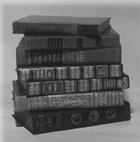|
History
of Distance Education
|
| "Distance
Education is not a new phenomenon, it has been practiced since
the turn of the century" (6).
One of the first forms of distance education was the correspondence
course, which took advantage of the then new rural free delivery
of mail. Distance education adopted other technologies as they
were developed to expand the media available to deliver educational
materials to students. Other media used for instructional delivery
included radio, television, audio, and video. The goal of this
section of the documentary is to examine the historical purpose,
mediums for delivery, early pioneers, and advantages and disadvantages
of distance education. For the purpose of this documentary, the
history will include the origins of distance education before
the widespread use of digital technologies (1840's to mid 1980's).
|

|
|
Historical
Timeline
1840
- Sir Issac Pitman is credited with inventing correspondence
courses by mail, which represented the first phase of distance
education.
1892 - 1st University
distance learning program offered through the University of
Chicago.
1911
- University of Queensland in Australia established a Department
of External Studies, which supported distance learning programs.
1920's - Federal
government issues the first educational radio licenses to deliver
distance education courses. Distance teaching is introduced
in universities in the Soviet Union.
1933- The world's first educational
television programs were broadcast from the University of Iowa.
1950 - Iowa State University
became the first educational television broadcaster in the world.
1969
- United Kingdom's Open University was founded. The OU introduced
a mixed-media approach to teaching distance learning courses.
1971
- PEACENET Founded - 1st to use satellites in distance education.
(5,
6 & 12)
|
|
Historical
Synonyms for Distance Education
-
Correspondence
Courses
-
Extension Courses
-
Distance Learning
-
Extended Studies
-
External Studies
- Home Study
- Continuing Education
|

|